are the World Champions
of 2018
October was quite a month! Now back to work!
Review materiel from previous classes and blog posts:
A. Continue to practice the small orbit meditation, using attention, breathing and any of the 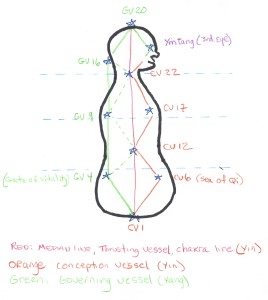 volumes, circles, spirals, arc and points that speak to you. This is a long term project, so be patient and keep with it
volumes, circles, spirals, arc and points that speak to you. This is a long term project, so be patient and keep with it
B. Learn the Five Skandhas and track them as they arise.
C. Learn Bonnie’s guide to an “Embodied Spiritual Practice” from the previous post and learn where you are in your own practice.
New Material:
A. Refining experience of the “Center Channel”, aka: sushumna, chakra line, thrusting vessel/Chong Mai, median line in sitting meditation.
B. Exploring the intangible mystery of ‘infinite space’ , as differentiated from the relational space we notice between things.
C. Integration of the spinal segments through sequential flexion and extension explorations to help open center channel.
Practices:
Meditation: increase sitting times, if possible, to 45 minutes or so, and ask: is the primary distraction physical (discomfort in the muscles/joints), emotional (breathing/heart rate will not settle down) or psychological ( mind wanders rather willfully).
What gets in the way of resting in stillness?
If physical, your asana practice needs to address this. What postures will help open/disentangle hips/lower spinal muscles and open the chest/heart region. Use K-1 and standing poses to start to free hip joints, climbing wall to lengthen core from tail to head, rotational/twisting postures to widen body.
If emotional, use breathing into lower dantien, either sitting or lying down, to shift energy and settle inner world. Work with the major points from the chart, especially CV-1, GV-1 at tip of coccyx, CV-6 and GV-4, to create a ‘bowl’ or flower pot to give a grounded base to support your center channel.
If psychological, first follow instructions for emotional distraction, and keep the attention in the lower body. Gradually begin to feel the ‘polarity’ between heaven and earth as a vibrational field, like that created by an archer drawing a bow, where the arrow is dynamically still through the opposite action of pushing the bow and pulling the string.
Now feel the polarity as an expanding and condensing sphere, so the whole body begins to feel spherical. Remain grounded while feeling the pull of the heavens, and feel full through the center, around your ‘equator’.
More Sitting
When you can find a moment or two of stillness in you sitting, notice spaciousness and then be spaciousness, dissolving the witness. Feel the central channel as spaciousness with a vibrancy, especially in the areas of the chakras. Allow your ‘identity’ to rest as open, unbounded spaciousness and not attach itself to any of the forms that are arising, whether structural, energetic or psychological.
Opening the Central Channel
One of the ways to help open the central channel is through learning to sequentially release the vertebrae, from tadasana, into in a standing forward bend, leading with skull going down, tail and hip joints coming up. This requires a continuous double action of lengthening from head down through tail/feet and feet/tail up through head.
In class we used the image from embryology of the converging of the caudal eminence (tail bud) and the neural tube at the 2nd sacral vertebrae which takes place around week 6 after conception. While standing standing, let your attention flow from the tip of the coccyx up through the interior of the sacrum and then, from the the 2nd sacral vertebra down to the tip of the coccyx. Notice how similar this action is to the integration of CV-1 and GV-1 back and forth across the anus at the root of the small orbit. Now travel up from the tail bud to S-2 and continue through the spine to the skull, and back down, through S-2 to the coccyx tip. Travel back and forth until you can sustain both at the same time, like an archer effortlessly drawing a bow.
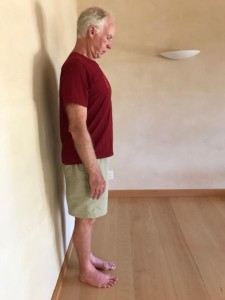 Now while holding the double action begin to drop the skull away from C-1 (skull up, C-1 down), then continue: C-1 up, C-2 down etc. You will/may find clumps of vertebrae that do not differentiate, especially at the base of the neck
Now while holding the double action begin to drop the skull away from C-1 (skull up, C-1 down), then continue: C-1 up, C-2 down etc. You will/may find clumps of vertebrae that do not differentiate, especially at the base of the neck 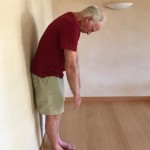 and behind the heart. Move as slowly as possible, and go in reverse for a vertebrae or two, if necessary, for clarity.
and behind the heart. Move as slowly as possible, and go in reverse for a vertebrae or two, if necessary, for clarity.
*** Keep lengthening in two directions through the groin/hips when the pelvis flexes around 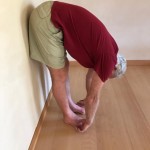 the femurs to prevent collapsing the anterior lumbar and compressing the discs. This especially important when reversing to come back to tadasana. This will be our base line for the spine
the femurs to prevent collapsing the anterior lumbar and compressing the discs. This especially important when reversing to come back to tadasana. This will be our base line for the spine
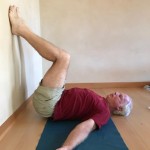 Sequential release of the vertebrae from lying down with feet on wall, leading with tail on the way up. Curl the sitting bones lightly to find the coccyx and continue to lift it up away from the floor. Feel each vertebrae, like links in a
Sequential release of the vertebrae from lying down with feet on wall, leading with tail on the way up. Curl the sitting bones lightly to find the coccyx and continue to lift it up away from the floor. Feel each vertebrae, like links in a 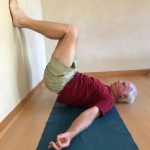 chain, lifting one at a time going up, and dropping one at a time on the way down. Feel the abdomen hollow so the lumbar vertebrae are hanging down in gravity to create space. when you get to T-12, keep lengthening the inside so as to not use your outer spinal
chain, lifting one at a time going up, and dropping one at a time on the way down. Feel the abdomen hollow so the lumbar vertebrae are hanging down in gravity to create space. when you get to T-12, keep lengthening the inside so as to not use your outer spinal 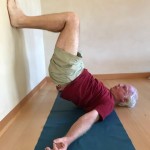 muscles. The small ones, the multifidi, we wish to engage, along with the transversus abdominis. Watch for compression in the throat. If stuck slide T-2, T-1, and then C-7 towards the tail.
muscles. The small ones, the multifidi, we wish to engage, along with the transversus abdominis. Watch for compression in the throat. If stuck slide T-2, T-1, and then C-7 towards the tail.
Supported sit ups to help challenging vertebrae.
The 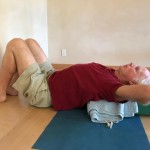 next action combines the previous two. This can be done with the legs out straight and pressing the wall, or, as shown, with legs bent. support the upper body with a bolster and blanket to whatever height feels right. then begin to curl up, starting with the skull, moving one vertebrae at a time.
next action combines the previous two. This can be done with the legs out straight and pressing the wall, or, as shown, with legs bent. support the upper body with a bolster and blanket to whatever height feels right. then begin to curl up, starting with the skull, moving one vertebrae at a time. 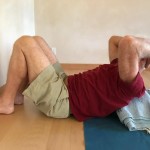 The hands support the weight of the head, but keep the elbows wide so the abdominals and not the pecs provide the lift. Let the abdomen stay hollow and feel the groins lengthening in two directions, like to curl from tadasana. Pause anywhere along the spine to zero in on the weak links.
The hands support the weight of the head, but keep the elbows wide so the abdominals and not the pecs provide the lift. Let the abdomen stay hollow and feel the groins lengthening in two directions, like to curl from tadasana. Pause anywhere along the spine to zero in on the weak links.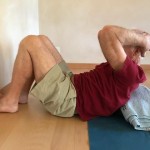 Feel the spine widening in the center, the front body squeezing across the transversus and the back body lengthening down to the tail from the action of the multifidi.
Feel the spine widening in the center, the front body squeezing across the transversus and the back body lengthening down to the tail from the action of the multifidi.
Thanks to Niel Asher Healthcare for this image of the multifidus muscles. They are quite fun to find and feel, as they run the the branches of a pine tree, downward and outward, vertebrae to vertebrae, and along with the rotatores, allow us to have a snakey feel to our spine and a lightness to our sitting.
In your sitting practice, after exploring these spinal actions, feel the center channel suspended in space between heaven and earth, each vertebrae supported by and floating in the center channel.
In part 2 we will add some breathing explorations and take these spinal practices into yoga postures that allow even more depth and integration of the core channel.


